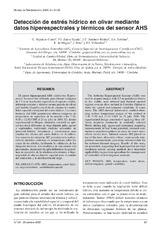Mostrar el registro sencillo del ítem
Detección de estrés hídrico en olivar mediante datos hiperespectrales y térmicos del sensor AHS
| dc.contributor.author | Sepulcre-Cantó, Guadalupe | |
| dc.contributor.author | Zarco-Tejada, Pablo J. | |
| dc.contributor.author | Jiménez-Muñoz, J.C. | |
| dc.contributor.author | Sobrino, J.A. | |
| dc.contributor.author | Miguel, E. de | |
| dc.contributor.author | Villalobos Martín, Francisco J. | |
| dc.date.accessioned | 2013-01-14T09:30:44Z | |
| dc.date.available | 2013-01-14T09:30:44Z | |
| dc.date.issued | 2005 | |
| dc.identifier.uri | http://hdl.handle.net/10396/8616 | |
| dc.description.abstract | El sensor hiperespectral AHS (Airborrne Hyperspectal Scanner) fue utilizado para obtener imágenes de 2.5 m de resolución espacial en el espectro visible, infrarrojo cercano y térmico en una parcela de olivar en Córdoba (España) con el fin de estudiar la variabilidad espacial y temporal del estrés hídrico. Los datos térmicos del AHS permitieron obtener imágenes de temperatura de superficie de la parcela a las 7:30, 9:30 y 12:30 GMT el 25 de julio de 2004. EL diseño experimental en bloques aleatorios consistió en aplicar tres dosis diferentes de riego durante julio, agosto y septiembre, realizando medidas semanales de potencial hídrico, fotosíntesis y conductancia para estudiar los efectos del estrés hídrico en el cultivo. Los sensores de infrarrojo IRT permitieron la realización de medidas continuas de temperatura sobre las copas de los árboles, facilitando la validación de las imágenes térmicas. Los resultados de este estudio son presentados, destacando la aplicabilidad en la agricultura de precisión de la teledetección térmica e hiperespectral de alta resolución espacial para el estudio del suministro y la dosificación del riego. | es_ES |
| dc.description.abstract | The Airborne Hyperspectral Scanner (AHS) was used to acquire images with 2.5 m spatiala resolution in the visible, near infrared and thermal spectral regions over an olive orchard in Cordoba (Spain) to study the spatial and temporal variability of water stress. The AHS thermal information enabled obtaining surface temperature images of the orchard at 7:30, 9:30 and 12:30 GMT in 25 july 2004. The experimental design consisted of applying three different irrigation treatments in randomly selected blocks during july, august and septemper, acquiring measurements of leaf water potential, stomatal conductance and photosynthesis to study the water stress effects on the trees. Infrared sensors IRT placed on top of the trees allowed to obtain continuously temperature measurements, providing validation data for the airborne thermal imagery. Results of this study are presented, suggesting that hyperspectral and high resolution remote sensing methods have important applicability in precision agriculture for management of controlled deficit irrigation methods | es_ES |
| dc.format.mimetype | application/pdf | es_ES |
| dc.language.iso | spa | es_ES |
| dc.publisher | Asociación Española de Teledetección | es_ES |
| dc.rights | https://creativecommons.org/licenses/by-nc-nd/4.0/ | es_ES |
| dc.source | Revista de Teledetección 24, 21-25 (2005) | es_ES |
| dc.subject | AHS | es_ES |
| dc.subject | Temperatura | es_ES |
| dc.subject | Tempertature | es_ES |
| dc.subject | Estrés hídrico | es_ES |
| dc.subject | Water stress | es_ES |
| dc.subject | Riego deficitario | es_ES |
| dc.subject | Variabilidad espacial | es_ES |
| dc.subject | Deficit irrigation | es_ES |
| dc.subject | Spatial variability | es_ES |
| dc.title | Detección de estrés hídrico en olivar mediante datos hiperespectrales y térmicos del sensor AHS | es_ES |
| dc.type | info:eu-repo/semantics/article | es_ES |
| dc.rights.accessRights | info:eu-repo/semantics/openAccess | es_ES |

